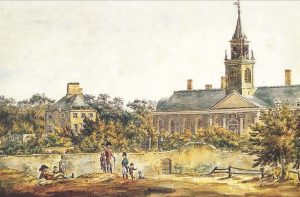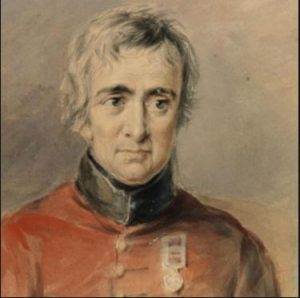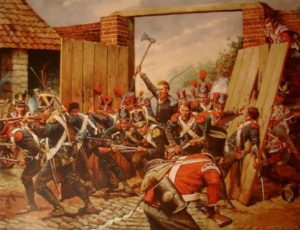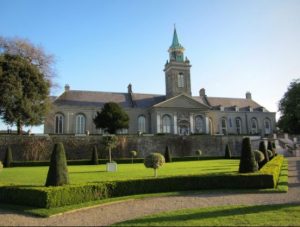While many people consider that the Royal Hospital in Kilmaimham, Dublin, is Ireland’s foremost classical building, one cannot ignore the fact that this building is one of many military installations constructed by the British government. One of the finest examples of 17th-century architecture in Ireland, this impressive landmark is located one and a half miles to the west of Dublin city centre, surrounded by former military barracks, magazines and auxiliary military buildings. Standing in isolation on a site that was once part of the Phoenix Park, this was to be the first major public building to be constructed in Dublin. The Royal Hospital was the starting point of Dublin city’s development into a European city of standing and also the British army’s first landmark building in the capital. Classical in layout and continental in style, the building has been part of Irish and British history for over three centuries.
The Hospital was built between 1680 and 1686 by Sir William Robinson, official State Surveyor for James Butler, 1st Duke Of Ormond and Lord Lieutenant of Ireland to King Charles II. Built as a retirement home for former and invalided soldiers who had served in the British army, the Royal Hospital also housed the Commander-in-Chief of British crown forces in Ireland who combined his role with that of Governor or Master of the hospital
As well as its original function, the building has played host to a number of events that have encompassed Royalty, Presidents and heads of state from around the world since its completion in 1686.
While there have been many famous people associated with the Royal Hospital, it is the pensioners that resided here who have left an indelible mark on the building’s history.
One of those soldiers has been described as the bravest man in the British Army, an accolade given by his commanding officer and one that you will here hear is very well deserved.
James Graham was born in 1791, in Clones, County Monaghan, Ireland. One of three brothers to serve in the British army, Graham enlisted in the 2nd Battalion of the Coldstream Guards in 1813, a regiment of Foot Guards considered one of a group of elite infantry regiments of the British Army.
Graham had joined the army as Europe was in turmoil after years of war.
Napoleon had waged almost continuous war from 1803 to 1814, inflicting crushing defeats on the major European powers. But in 1812, his insatiable ambition led him to invade Russia – with disastrous results. Beaten as much by the great distance involved and the cruel weather as by Russian numerical superiority. he was obliged to abandon his army and return hurriedly to Paris to raise more troops.
Russia, Austria, Prussia and Great Britain united and advanced on France. Unable to repel invasion, Napoleon was forced to abdicate in 1814. The Sénet Conservateur, a French parliamentary body, believed that the allied armies were fighting against Napoleon and not France and accepted the honourable peace terms put forward by the alliance if Napoleon were removed from power. The next day, the Sénat passed the “Emperor’s Demise Act”, which declared Napoleon deposed. Napoleon’s armies refused to continue to fight and the emperor was then forced to announce his unconditional abdication only two days later.
In the Treaty of Fontainebleau that followed, the victors exiled him to Elba, an island of 12,000 inhabitants in the Mediterranean. They gave him sovereignty over the island and allowed him to retain his title of emperor.
In February 1815, Napoleon escaped from the island of Elba and reached France where he mustered his old army and dethroned the Bourbon King Louis XVIII and made himself emperor of France. Many states that had opposed him formed the seventh coalition and started mobilising their armies. In the same year on June 18th, he clashed with the Duke of Wellington at Waterloo, a hamlet ten miles south of Brussels.
The Battle of Waterloo was fought on Sunday 18 June 1815, near Waterloo in present-day Belgium, then part of the United Kingdom of the Netherlands. A French army under the command of Napoleon was pitched against the armies of the Seventh Coalition comprising an Anglo-allied army under the command of the Duke of Wellington combined with a Prussian army under the command of Gebhard von Blucher.
Many of us are familiar with the character Major Richard Sharpe devised by Bernard Cornwell and made famous by the actor Seán Bean. It was this army, that James Graham found himself marching into battle at Waterloo.
Wellington’s ridge south of Mont St. Jean was endowed with three natural outposts or strong points, of which Hougoumont Farm was the largest, the others being La Haie Sainte and the Papelotte/la Haie/Smohain. They acted as breakwaters jutting out from the flanks and centre of his main position. Occupied, they would divide, channel and weaken the force of frontal attacks, just as breakwaters do with an advancing tide. However, if occupied by the enemy, they would seriously threaten the main position, providing ideal bases from which to launch strong assaults at close range.
Wellington fortified the Chateau of Hougoumont during the night before the battle. The complex comprised a farmhouse, granaries, cowsheds and barns. Napoleon planned to draw Wellington’s reserve to Wellington’s right flank in defence of Hougoumont and then attack through the centre-left of the British and allies’ front near La Haye Sainte.
Before the battle started, Hougoumont and its gardens, located on the allies’ right flank, were garrisoned and fortified by the 1st Battalion, 2nd Nassau Regiment, with additional detachments of jägers and landwehr from von Kielmansegge’s 1st (Hanoverian) Brigade. The light company of the 2nd Battalion, Coldstream Guards under the command of Lt-Colonel Henry Wyndham, was also stationed in the farm and chateaux, and the light company of the 2nd Battalion, Third Guards, under Lt-Colonel Charles Dashwood in the garden and grounds. The two light companies of the 2nd and 3rd Battalions, First Guards were initially positioned in the orchard, under the command of Lt-Colonel Lord Saltoun. Lieutenant-Colonel James Macdonnell, Coldstream Guards, had overall command of Hougoumont. (The Guards units were all drawn from General John Byng’s 2nd (British) Brigade.)
Wellington recorded in his dispatches “at about ten o’clock [Napoleon] commenced a furious attack upon our post at Hougoumont” Other sources state that this attack was at about 11:30. The historian Andrew Roberts notes that “It is a curious fact about the battle of Waterloo that no one is absolutely certain when it actually began.”
The initial attack by Maréchal de Camp Bauduin’s 1st Brigade of the 6th Division emptied the wood and park, but was driven back by heavy British artillery fire and cost Bauduin his life. The British guns were distracted into an artillery duel with French guns and this allowed a second attack by Maréchal de Camp Baron Soye’s 2nd Brigade of the 6th Division. They managed a small breach on the south side but could not exploit it. An attack on the north side by elements of the 1st Brigade of the 6th Division was more successful. The north gate of Hougoumont Farm was left deliberately left open to allow free and speedy access for supplies and friendly troops. However, the French noticed this and attacked the gate.
The complex was flanked by an orchard on one side and a wood on the other. French troops came undetected through the orchard towards the complex and opened fire on the British defenders that were taken by surprise. This attack was the beginning of one of the most famous skirmishes in the Battle of Waterloo
A desperate fight ensued between the invading French soldiers and the defending Guards resulting in ferocious hand-to-hand fighting.
By 12.30pm MacDonnell had been pushed back along the west side of the buildings, so his companies used the north gate to withdraw, under pressure into the northern courtyard of the chateau. though they managed to get inside they did not have enough time to secure the gates properly. Shots were fired through the woodwork, seriously injuring some of the officers in command.
Within moments heavy axe blows combined with the pressure of a dozen bodies forced the doors open. The axe was wielded by Sous-lieutenant Legros of the 1st Company, 2nd Battalion, 1st legére regiment. A powerful man is known as L’enfonceur, formally an engineer who had risen through the ranks, Legros burst into the compound at the head of his men. there was some desperate hand-to-hand fighting. a number of the defenders fell back and took up position in some of the farm building, shooting from the windows or doors into the mêlée A lieutenant in a Grenadier Company was chased as far as the farmhouse where in a bid to defend himself from the attack had his hand severed.
Wellington was within a whisker of losing Hougoumont. MacDonnell realised that the gates must be closed at all costs to stop the French from pouring in and taking the complex.
In a near-miraculous counter-attack, MacDonnell, a small party of officers along with Corporal James Graham, his brother Joseph Graham, sergeants Fraser, McGregor and Aston and Private Lester fought through the melee to shut the gate, trapping Legros and about 30 other soldiers of the 1st Legere inside. While some heaved on the gates, others fought with bayonets or swords to beat back more of the enemy as they arrived. Slowly the gates were closed together, barricaded and the crossbar dropped into position.
All of the French who entered, apart from a young drummer boy, were killed in a desperate hand-to-hand fight. The British and German Garrison were running low on ammunition and Private Brewster of the Royal Wagon Train distinguished himself by driving an ammunition cart through the French lines to re-supply the troops despite his horses receiving wounds. He was later promoted to Corporal for his heroic action and was presented with a silver medal for bravery by the Officers of the Coldstream Guards. The medal is held in the Collection of The RASC and RCT at Deepcut, Home of The Royal Logistic Corps. This was a forerunner of action likely to receive the highest award in modern warfare. The French attack in the immediate vicinity of the farm was repulsed by the arrival of the 2nd Coldstream Guards and 2/3rd Foot Guards. Fighting continued around Hougoumont all afternoon with its surroundings heavily invested with French light infantry and coordinated cavalry attacks sent against the troops behind Hougoumont.
Wellington’s army defended the house and the hollow way running north from it. In the afternoon Napoleon personally ordered the shelling of the house to cause it to burn,[8] resulting in the destruction of all but the chapel. Du Plat’s brigade of the King’s German Legion was brought forward to defend the hollow way, which they had to do without any senior officers, who were then relieved by the 71st Foot, a Scottish light infantry regiment. Adam’s brigade, further reinforced by Hugh Halkett’s 3rd (Hanoverian) Brigade, successfully repulsed further infantry and cavalry attacks sent by Reille and maintained the occupation of Hougoumont until the end of the battle.
In a history of the battle, the following extract captures the intensity of the battle and the actions of Graham.
The French, however, succeeded in forcing the gate (of Hougoumont); but the defenders betook themselves to the nearest cover, whence they poured fire upon the intruders, and then rushing forward a struggle ensued which was distinguished by the most intrepid courage on both sides. At length Lieut-Colonel MacDonnell, Captain Wyndham, Ensigns Gooch and Hervey and Sergeant Graham, of the Coldstream Guards, by dint of personal strength and exertions, combined with extraordinary bravery and perseverance, succeeded in closing the gate against their assailants.
This individual, (Sgt Graham), deserves an honourable mention, having greatly distinguished himself during the defence of Hougoumont. At a later period of the day, when in the ranks along the garden wall facing the wood, and when the struggle was most severe in that quarter, he asked Lieut-Colonel MacDonnell permission to fall out. The Colonel, knowing the character of the man, expressed his surprise at the request made at such a moment. Graham explained that his brother lay wounded in one of the buildings then on fire, that he wished to remove him to a place of safety, and that he would then lose no time in rejoining the ranks. The request was granted: Graham succeeded in snatching his brother from the horrible fate which menaced him, laid him in a ditch in rear of the enclosures, and, true to his word, was again at his post.
Early in August of that year, and while the Anglo allied army was at Paris, the Duke of Wellington received a letter from the rev. Mr. Norcross, rector of Framlingham, in Suffolk, expressing his wish to confer a pension of £10 a year, for life, on some Waterloo soldier to be named by his grace. The Duke requested Sir John Byng to choose a man from the 2nd Brigade of guards, which had so highly distinguished itself in the defence of Hougoumont. Out of numerous instances of good conduct evinced by several individuals of each battalion, Sergeant James Graham, of the light company of the Coldstream, was selected to receive the proffered annuity, as notified in brigade orders of the 9th August 1815. this was paid to him for two years, at the expiration of which period ceased, in consequence of the bankruptcy of the benevolent donor.[1]
Hours of intense fighting followed, with the scales once more tipping towards the British when General Blucher’s Prussian force arrived at the battle around 4.30 pm. It was the Prussian army that attacked Napoleon’s right flank and caused chaos, giving Wellington the upper hand and, with his forces losing discipline and ground, Napoleon ordered a retreat. Wellington’s leadership, some uncharacteristic mistakes by Napoleon and the boggy ground of the battlefield all played key roles, but the arrival of the Prussians and the action at Hougoumont was decisive. The battle of Waterloo had cost the lives of 22,000 men of the allied forces and the French army as many as 32,000 men. The casualties suffered at Waterloo was not to be surpassed until the devastation that caused World War One.
In the aftermath of Waterloo Graham continued his service with the British Army and was discharged from the Guards in 1821 but re-enlisted in the 12th Royal Lancers as a private. He saw service overseas and was discharged for ill health in July 1830, receiving a Chelsea Pension.
Graham died in 1845, at the Royal Hospital, Kilmainham. He was buried with military honours.
A memorial plaque was erected at the Hospital but was later transferred to St. Tiernach’s Church in Clones.
An obituary in The Gentleman’s Magazine under the name of ‘John Graham.’
23 April: At the Royal Hospital Kilmainham, Sergeant John Graham formally in the light company of the 2nd Battalion of Coldstream Guards, the individual selected by the Duke of Wellington as ‘the braves of the brave’ in the desperate combat at Waterloo, in order to profit by the generous offer of the Rev. Mr. Norcross, Rector of Framlingham, to confer a pension, during life, upon the soldier most distinguished in the brigade of guards on that glorious day. After the most minute enquiry, carried out by Sir John Byng’s directions, the laurel was awarded to an Irishman, John Graham, a native of Cloona (sic) Co. Monaghan.
The efforts of the Coldstream Guards at Waterloo, and Graham’s gallantry are celebrated every year by
the regiment. Every December the Sergeants mess commemorates Graham’s bravery with a ceremonial game known as ‘Hanging the Brick.’ The ‘Brick’ – a stone from Hougoumont – is paraded through the barracks and hung up in the sergeant’s mess with all the honours due. Graham’s medals are also held by the regiment.
In 2004 a building within the barracks was named after Graham. A plaque unveiled on the building reads,
‘In memory of Sergeant James Graham WM, 2nd Battalion Coldstream Guards, ‘The Bravest Man in England’, Following his actions in closing the gates at Hougoumont Farm, Waterloo, 18 June 1815.’
Europe was spared further major conflict, save for the Crimean War, for the greater part of the century.
By the outbreak of the First World War, the technological advances of the 19th century had given armies a new arsenal of weapons, which radically altered military practice. Machine-guns had been introduced, grenades were more deadly and rifles more accurate; most important of all, artillery could inflict greater damage than ever before. Never again would a battle be fought in the time-honoured style of Waterloo.
I had the honour of being involved in the erection of anew plaque to Sergeant James Graham that can now be seen at the Royal Hospital in Kilmainham, Dublin, Ireland.
[1] Childers, Major E.S.E, The Story of the Royal Hospital Kilmainham ( Naval & Military Press, London, 2005)




